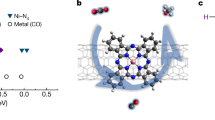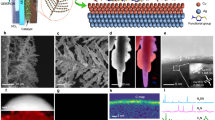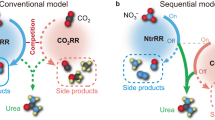Abstract
The electrochemical reduction of carbon dioxide is an appealing technology that stores renewable electricity in the chemical form and has the potential to transform the way carbon fuels are utilized today. While there have been successes in the electrosynthesis of alkanes, alkenes and alcohols, access to organonitrogen molecules such as alkylamines remains largely beyond the reach of current electrocatalysis. Here we report the first electrochemical reaction that converts carbon dioxide and nitrate to methylamine in aqueous media under ambient conditions catalysed by a cobalt β-tetraaminophthalocyanine molecular catalyst supported on carbon nanotubes. The overall reaction, involving the transfer of 14 electrons and 15 protons to form each methylamine molecule, is an eight-step catalytic cascade process enabled by the coupling of two reactive intermediates near the catalyst surface. The key C–N bond-forming step is found to be the spillover of hydroxylamine from nitrate reduction and its subsequent condensation with formaldehyde from carbon dioxide reduction. This study provides a successful example of sustainable alkylamine synthesis from inorganic carbon and nitrogen wastes, which could contribute to greenhouse gas mitigation for a carbon-neutral future.
This is a preview of subscription content, access via your institution
Access options
Access Nature and 54 other Nature Portfolio journals
Get Nature+, our best-value online-access subscription
$29.99 / 30 days
cancel any time
Subscribe to this journal
Receive 12 digital issues and online access to articles
$119.00 per year
only $9.92 per issue
Buy this article
- Purchase on Springer Link
- Instant access to full article PDF
Prices may be subject to local taxes which are calculated during checkout



Similar content being viewed by others
Data availability
The data supporting the findings of this study are available from the corresponding authors upon reasonable request.
References
Resasco, J. & Bell, A. T. Electrocatalytic CO2 reduction to fuels: progress and opportunities. Trends Chem. 2, 825–836 (2020).
De Luna, P. et al. What would it take for renewably powered electrosynthesis to displace petrochemical processes? Science 364, eaav3506 (2019).
Liu, A. et al. Current progress in electrocatalytic carbon dioxide reduction to fuels on heterogeneous catalysts. J. Mater. Chem. A 8, 3541–3562 (2020).
Jouny, M., Hutchings, G. S. & Jiao, F. Carbon monoxide electroreduction as an emerging platform for carbon utilization. Nat. Catal. 2, 1062–1070 (2019).
Giddey, S., Badwal, S. P. S. & Kulkarni, A. Review of electrochemical ammonia production technologies and materials. Int. J. Hydrog. Energy 38, 14576–14594 (2013).
Wu, Y., Jiang, Z., Lu, X., Liang, Y. & Wang, H. Domino electroreduction of CO2 to methanol on a molecular catalyst. Nature 575, 639–642 (2019).
Li, F. et al. Cooperative CO2-to-ethanol conversion via enriched intermediates at molecule–metal catalyst interfaces. Nat. Catal. 3, 75–82 (2020).
Liu, Y. et al. Steering CO2 electroreduction toward ethanol production by a surface-bound Ru polypyridyl carbene catalyst on N-doped porous carbon. Proc. Natl Acad. Sci. USA 116, 26353–26358 (2019).
Francis, S. A. et al. Reduction of aqueous CO2 to 1-propanol at MoS2 electrodes. Chem. Mater. 30, 4902–4908 (2018).
Chebotareva, N. & Nyokong, T. Metallophthalocyanine catalysed electroreduction of nitrate and nitrite ions in alkaline media. J. Appl. Electrochem. 27, 975–981 (1997).
Brylev, O., Sarrazin, M., Roué, L. & Bélanger, D. Nitrate and nitrite electrocatalytic reduction on Rh-modified pyrolytic graphite electrodes. Electrochim. Acta 52, 6237–6247 (2007).
Wang, Y., Zhou, W., Jia, R., Yu, Y. & Zhang, B. Unveiling the activity origin of a copper-based electrocatalyst for selective nitrate reduction to ammonia. Angew. Chem. Int. Ed. Engl. 59, 5350–5354 (2020).
McEnaney, J. M. et al. Electrolyte engineering for efficient electrochemical nitrate reduction to ammonia on a titanium electrode. ACS Sustain. Chem. Eng. 8, 2672–2681 (2020).
IPCC Climate Change 2014: Synthesis Report (eds Core Writing Team, Pachauri, R. K. & Meyer, L. A.) (IPCC, 2014).
Doney, S. C., Fabry, V. J., Feely, R. A. & Kleypas, J. A. Ocean acidification: the other CO2 problem. Annu. Rev. Mar. Sci. 1, 169–192 (2009).
Ward, M. H. et al. Drinking water nitrate and human health: an updated review. Int. J. Environ. Res. Public Health 15, 1557 (2018).
Shibata, M., Yoshida, K. & Furuya, N. Electrochemical synthesis of urea on reduction of carbon dioxide with nitrate and nitrite ions using Cu-loaded gas-diffusion electrode. J. Electroanal. Chem. 387, 143–145 (1995).
Shibata, M. & Furuya, N. Electrochemical synthesis of urea at gas-diffusion electrodes: Part VI. Simultaneous reduction of carbon dioxide and nitrite ions with various metallophthalocyanine catalysts. J. Electroanal. Chem. 507, 177–184 (2001).
Corbin, D. R., Schwarz, S. & Sonnichsen, G. C. Methylamines synthesis: a review. Catal. Today 37, 71–102 (1997).
Joppich, M., Joppich-Kuhn, R., Sentissi, A. & Giese, R. W. Single-step, quantitative derivatization of amino, carboxyl, and hydroxyl groups in iodothyronine amino acids with ethanolic pivalic anhydride containing 4-dimethylaminopyridine. Anal. Biochem. 153, 159–165 (1986).
Chen, C. et al. Coupling N2 and CO2 in H2O to synthesize urea under ambient conditions. Nat. Chem. 12, 717–724 (2020).
Jouny, M. et al. Formation of carbon–nitrogen bonds in carbon monoxide electrolysis. Nat. Chem. 11, 846–851 (2019).
Boutin, E. et al. Aqueous electrochemical reduction of carbon dioxide and carbon monoxide into methanol with cobalt phthalocyanine. Angew. Chem. Int. Ed. Engl. 58, 16172–16176 (2019).
Marvel, C. S. & Jenkins, R. L. Methylamine hydrochloride. Organic Synth. 3, 67 (1923).
Wu, Y., Hu, G., Rooney, C. L., Brudvig, G. W. & Wang, H. Heterogeneous nature of electrocatalytic CO/CO2 reduction by cobalt phthalocyanines. ChemSusChem 13, 6296–6299 (2020).
Duca, M. & Koper, M. T. M. Powering denitrification: the perspectives of electrocatalytic nitrate reduction. Energy Environ. Sci. 5, 9726–9742 (2012).
Garcia-Segura, S., Lanzarini-Lopes, M., Hristovski, K. & Westerhoff, P. Electrocatalytic reduction of nitrate: fundamentals to full-scale water treatment applications. Appl. Catal. B 236, 546–568 (2018).
Rosenberg, S., Silver, S. M., Sayer, J. M. & Jencks, W. P. Evidence for two concurrent mechanisms and a kinetically significant proton transfer process in acid-catalyzed O-methyloxime formation. J. Am. Chem. Soc. 96, 7986–7998 (1974).
Wu, Z., Liang, H. & Lu, J. Synthesis of poly(N-isopropylacrylamide)−poly(ethylene glycol) miktoarm star copolymers via RAFT polymerization and aldehyde−aminooxy click reaction and their thermoinduced micellization. Macromolecules 43, 5699–5705 (2010).
Hudak, J. E. et al. Synthesis of heterobifunctional protein fusions using copper-free click chemistry and the aldehyde tag. Angew. Chem. Int. Ed. Engl. 51, 4161–4165 (2012).
Chatterjee, T., Boutin, E. & Robert, M. Manifesto for the routine use of NMR for the liquid product analysis of aqueous CO2 reduction: from comprehensive chemical shift data to formaldehyde quantification in water. Dalton Trans. 49, 4257–4265 (2020).
Chelex® 100 and Chelex 20 Chelating Ion Exchange Resin Instruction Manual (Bio-Rad, 2000).
Irvine, J. T. S., Eggins, B. R. & Grimshaw, J. The cyclic voltammetry of some sulphonated transition metal phthalocyanines in dimethylsulphoxide and in water. J. Electroanal. Chem. Interf. Electrochem. 271, 161–172 (1989).
Lieber, C. M. & Lewis, N. S. Catalytic reduction of carbon dioxide at carbon electrodes modified with cobalt phthalocyanine. J. Am. Chem. Soc. 106, 5033–5034 (1984).
Jensen, K. A., Holm, A. & Andersen, F. A. Investigations of Formaldehyde Oxime, Its Polymers and Coordination Compounds Vol. 1 (Kongelige Danske Videnskabernes Selskab, 1978).
Snell, F. D. & Snell, C. T. Colorimetric Methods of Analysis (D. van Nostrand, 1959).
Fortune, W. B. & Mellon, M. G. Determination of iron with o-phenanthroline: a spectrophotometric study. Ind. Eng. Chem. Anal. Ed. 10, 60–64 (1938).
Bower, C. E. & Holm-Hansen, T. A salicylate–hypochlorite method for determining ammonia in seawater. Can. J. Fish. Aquat. Sci. 37, 794–798 (1980).
Acknowledgements
The work at Yale was supported by the US National Science Foundation (grant no. CHE-1651717). The work at Southern University of Science and Technology was supported by the National Science Foundation of China (grant no. 22075125). Y.W. acknowledges the Dox Fellowship from Yale University. H.W. acknowledges the Sloan Research Fellowship.
Author information
Authors and Affiliations
Contributions
Y.W. and H.W. conceived the project and designed the experiments. Y.W., Z.J. and Z.L. performed the experiments and analysed the data with input from Y.L. and H.W. Y.W. and H.W. wrote the manuscript with input from all other authors. Y.L. and H.W. supervised the project.
Corresponding authors
Ethics declarations
Competing interests
The authors declare no competing interests.
Additional information
Peer review information Nature Sustainability thanks Feng Jiao and the other, anonymous, reviewer(s) for their contribution to the peer review of this work.
Publisher’s note Springer Nature remains neutral with regard to jurisdictional claims in published maps and institutional affiliations.
Extended data
Extended Data Fig. 1 Liquid-phase and gas-phase product quantification.
UV-vis spectra and calibration curves (with linear fitting equations and R2 values) for colorimetric quantification of a,b, NO2−, c,d, NH2OH and e,f, NH3. Typical gas chromatography diagrams from g, the flame ionization detector and h, the thermal conductivity detector, showing the presence of CO, CO2 and H2. Calibration curves for i, CO and j, H2.
Extended Data Fig. 2 Electrochemical NO3− reduction catalyzed by CoPc-NH2/CNT.
a, Potential-dependent product selectivity and current density of electrochemical NO3− reduction catalyzed by CoPc-NH2/CNT. 24 min electrolyses were carried out in an Ar-saturated aqueous solution containing 0.1 M PBS and 0.5 M KNO3. b, 1H NMR spectrum of the catholyte solution after electrochemical NO3− reduction at −0.94 V.
Extended Data Fig. 3 Identification of liquid-phase products from co-reduction in NMR spectra.
Typical a, 1H NMR and b, 13C NMR spectra of the catholyte solution after co-reduction stacked together with standard spectra of methylamine, N-methylhydroxylamine and formaldoxime dissolved in fresh CO2-saturated electrolyte solutions.
Extended Data Fig. 4 Further confirmation of methylamine formation and its C, N sources.
a, Standard mass spectrum of N-methylpivalamide from NIST Mass Spectral Library. b, 1H NMR spectrum of methylamine after electrolysis in 0.1 M PBS + 0.5 M KNO3 under 13CO2 for 30 min at −0.95 V vs RHE. c, 1H NMR spectrum of formaldoxime, N-methylhydroxylamine and methylamine after electrolysis in 0.1 M KHCO3 + 0.5 M K15NO3 under CO2 for 5 h at −0.91 V vs RHE. The green traces show the 1H NMR spectra of formaldoxime, N-methylhydroxylamine and methylamine from co-reduction of unlabeled CO2 and NO3−.
Extended Data Fig. 5 Statistics of reaction rate and selectivity.
Potential-dependent a, jmethylamine and b, FEmethylamine values measured from 27 independent co-reduction electrolyses of CO2 and NO3− in 0.1 M KHCO3 + 0.5 M KNO3 electrolyte.
Extended Data Fig. 6 Determination of the loading of electrochemically active CoPc-NH2 on the electrode.
Integration of the one-electron reduction peak in the cyclic voltammogram to determine the loading of electrochemically active CoPc-NH2 molecules. Scan rate: 10 mV/s.
Extended Data Fig. 7 Identification of key N intermediates.
1H NMR spectra of catholyte solutions after reduction of a, CO2 in the presence of NH4HCO3 and b, CO in the presence of NH4OH. Stacked together are spectra of CH3OH and methylamine co-dissolved in 0.1 M KOH and electrolyte solution after co-reduction of CO and NO3−. c, 1H NMR spectra of catholyte solutions after co-reduction of CO2 in 0.1 M PBS with different N sources: KNO3, NaNO2, NO and NH2OH. The peaks pertaining to methylamine are highlighted in green.
Extended Data Fig. 8 Identification of key C intermediates.
1H NMR spectra of catholyte solutions after co-reduction of KNO3 with different C sources in 0.1 M PBS: a, CO, b, HCHO and c, CH3OH. The peaks pertaining to methylamine are highlighted in green.
Extended Data Fig. 9 Electrochemical reducibility of formaldoxime and N-methylhydroxylamine to methylamine.
1H NMR spectra of catholyte solutions after electroreduction of a, formaldoxime and b, N-methylhydroxylamine in Ar-saturated 0.1 M PBS. The peaks pertaining to methylamine are highlighted in green.
Extended Data Fig. 10 Condensation between formaldehyde and hydroxylamine to form formaldoxime.
a, 1H NMR spectra of 25 mM HCHO dissolved in electrolyte solution before and after adding 50 mM NH2OH. Peaks pertaining to formaldoxime are highlighted in purple. b, 1H NMR spectrum of the catholyte solution after co-reduction mixed with 1 M NaHSO3. Stacked together are spectra of HCHO and formaldoxime mixed with 1 M NaHSO3. Only the reaction product between formaldoxime and NaHSO3 (~4.00 ppm) but no reaction product between HCHO and NaHSO3 (~4.39 ppm) can be found.
Rights and permissions
About this article
Cite this article
Wu, Y., Jiang, Z., Lin, Z. et al. Direct electrosynthesis of methylamine from carbon dioxide and nitrate. Nat Sustain 4, 725–730 (2021). https://doi.org/10.1038/s41893-021-00705-7
Received:
Accepted:
Published:
Issue Date:
DOI: https://doi.org/10.1038/s41893-021-00705-7
This article is cited by
-
Pulsed co-electrolysis of carbon dioxide and nitrate for sustainable urea synthesis
Nature Sustainability (2024)
-
Synthesis of hydroxylamine from air and water via a plasma-electrochemical cascade pathway
Nature Sustainability (2024)
-
Prospects of formamide as nitrogen source in biotechnological production processes
Applied Microbiology and Biotechnology (2024)
-
Tuning electronic properties of cobalt phthalocyanines for oxygen reduction and evolution reactions
Science China Chemistry (2024)
-
Upgrading waste NOx into amino acids via electrocatalysis on Co nanoparticles encapsulated in hollow carbon nanofibers
Science China Chemistry (2024)



